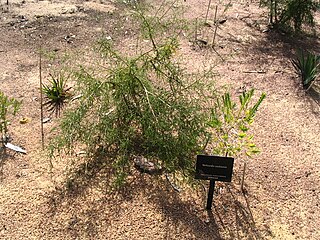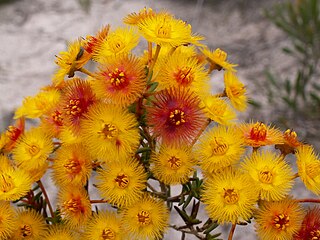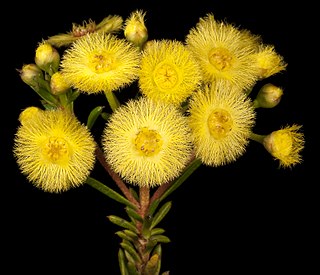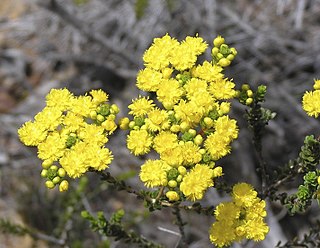
Verticordia acerosa is a flowering plant in the myrtle family, Myrtaceae and is endemic to the south-west of Western Australia. It is a shrub with yellow flowers which change colour through red to almost black as they age. There are two varieties which vary in their leaf shape, their flower colour and some of the structures in the flower.

Verticordia citrella is a flowering plant in the myrtle family, Myrtaceae and is endemic to the south-west of Western Australia. It is a small, densely-branched shrub with cylinder shaped stem leaves that differ from those near the flowers, and small yellow flowers in groups near the ends of the branches.
Verticordia amphigia commonly known as pixie ears is a flowering plant in the myrtle family, Myrtaceae and is endemic to the south-west of Western Australia. It is usually an open, much-branched shrub with narrow leaves and yellow flowers which sometimes produce a "sea" of colour in the wild. The flowers are surrounded by boat-shaped bracteoles which give the plant both its common and scientific names.
Verticordia aurea, commonly known as buttercups is a flowering plant in the myrtle family, Myrtaceae and is endemic to the south-west of Western Australia. It is a slender, sometimes bushy shrub with a single stem at the base, cylindrical leaves and heads of scented, golden-yellow flowers in spring.
Verticordia brevifolia is a flowering plant in the myrtle family, Myrtaceae and is endemic to the south-west of Western Australia. It is a small shrub with shortly cylindrical leaves and bright yellow flowers which turn red as they age. There are two subspecies, both of which have limited distributions and a priority conservation rating.
Verticordia patens is a flowering plant in the myrtle family, Myrtaceae and is endemic to the south-west of Western Australia. It is a shrub with linear, pointed leaves and faintly scented, pale yellow flowers in open heads on the ends of the branches. It is fairly common in a small area south of Badgingarra.

Verticordia venusta is a flowering plant in the myrtle family, Myrtaceae and is endemic to the south-west of Western Australia. It is an openly branched shrub with small, egg-shaped leaves and spikes of pink to maroon-coloured flowers in spring and early summer.

Verticordia galeata is a flowering plant in the myrtle family, Myrtaceae and is endemic to the south-west of Western Australia. It is a woody shrub with thin, pointed cylinder-shaped leaves and heads of bright yellow flowers on the ends of the branches in spring.

Verticordia cooloomia, commonly known as Cooloomia verticordia, is a flowering plant in the myrtle family, Myrtaceae and is endemic to the south-west of Western Australia. It is an open, spreading shrub with large heads of sharply scented yellow flowers and is only known from areas in and near to the Cooloomia Nature Reserve, near the Murchison River.

Verticordia staminosa is a flowering plant in the myrtle family, Myrtaceae and is endemic to the south-west of Western Australia. It is a shrub comprising two subspecies, one of which has two varieties. All three types have a limited distribution and have been classified as "Threatened". It is distinguished from other species of verticordia by its prominent, long stamens which extend well beyond its feathery yellow sepals and petals.

Verticordia chrysantha, commonly known as yellow featherflower or yellow Morrison, is a flowering plant in the myrtle family, Myrtaceae and is endemic to Western Australia. It is a small, slow-growing, rather bushy shrub with bright yellow flowers which often turn reddish-brown as they age. It is widespread in the south-west of the state.

Verticordia chrysanthella, commonly known as little chrysantha, is a flowering plant in the myrtle family, Myrtaceae and is endemic to the south-west of Western Australia. It is a shrub with cylinder-shaped leaves and small groups of lemon-yellow to gold-coloured flowers which fade to orange, red or brown.
Verticordia coronata is a flowering plant in the myrtle family, Myrtaceae and is endemic to the south-west of Western Australia. It is a small shrub with leaves whose shape depends on their position on the plant, and groups of yellow flowers near the ends of the branches.

Verticordia endlicheriana is a flowering plant in the myrtle family, Myrtaceae and is endemic to the south-west of Western Australia. It is a shrub with narrow leaves and yellow flowers which in some varieties age to red. It is a variable species and in his 1991 paper, Alex George formally described five varieties.
Verticordia endlicheriana var. major is a flowering plant in the myrtle family, Myrtaceae and is endemic to the south-west of Western Australia. It is a small, compact shrub with lightly-scented, lemon-yellow flowers which do not change colour as they age.

Verticordia grandiflora, commonly known as claw featherflower, clawed featherflower or horned featherflower, is a flowering plant in the myrtle family Myrtaceae, and is endemic to the south-west of Western Australia. It is a small, rigid shrub with many short side-branches, mostly linear leaves and heads of yellow flowers which soon age to reddish but which are among the largest in the genus. It is similar in appearance to several other species of verticordias with which it is often confused.

Verticordia laciniata is a flowering plant in the myrtle family, Myrtaceae and is endemic to the south-west of Western Australia. It is an openly branched shrub with linear, slightly hairy leaves and heads of scented, bright yellow flowers which turn red then bronze-coloured as they age.
Verticordia mirabilis is a flowering plant in the myrtle family, Myrtaceae and is endemic to a small area in the Gibson Desert. It is a bushy, spreading shrub with its leaves mostly crowded on short side branches and with large, deep red flowers in small groups in spring.

Verticordia rutilastra, commonly known as little grandiflora, is a flowering plant in the myrtle family Myrtaceae and is endemic to Southwest Australia, a biodiversity hotspot in Western Australia. It is a small shrub with short upper branches, narrow leaves and yellow, feathery flowers, often with a star-like red centre.

Verticordia serrata is a flowering plant in the myrtle family, Myrtaceae and is endemic to the south-west of Western Australia. It is a spindly or openly branched shrub with hairy, egg-shaped leaves and flowers which are golden at first, then fade to a greyish colour.













